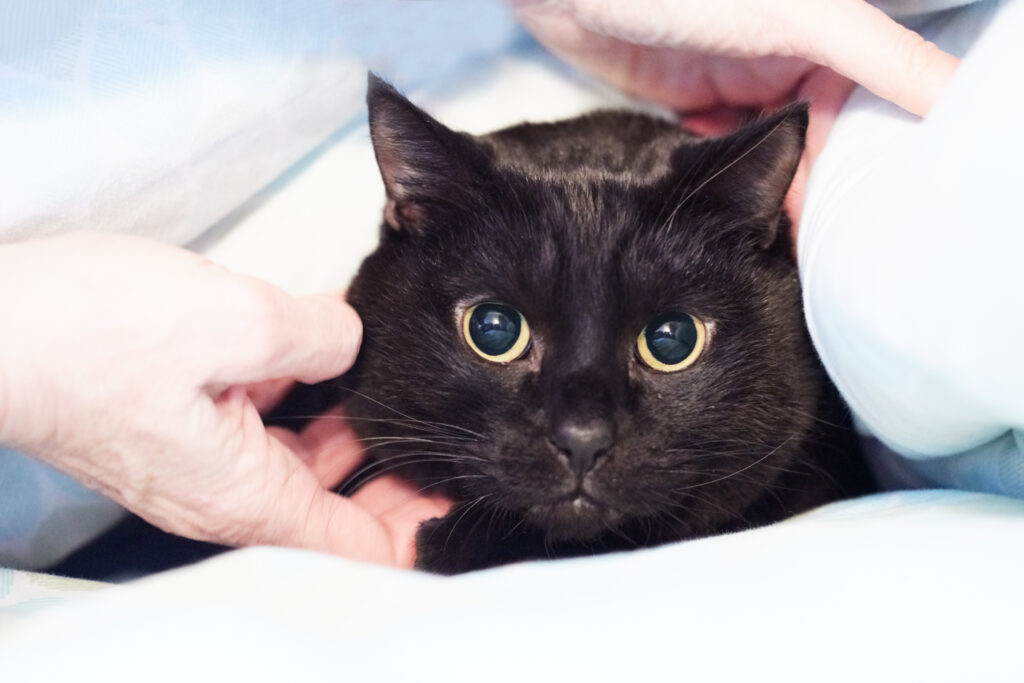Under the bed, in the closet, behind the couch–wherever your shy or fearful cat calls “home,” it can be frustrating and disappointing to try to befriend a kitty who’s nervous around you.
You know you’re offering a warm and loving place to live, and you want to show your affection … But your cat doesn’t necessarily understand that. Don’t worry, though: with a few strategies and some patience, you can help them learn to be comfortable, unguarded, and loving with you!
Why so Shy?
It’s hard to explain exactly why an individual cat is showing shy or fearful behavior, but it often stems from unfamiliarity with humans or their surroundings, underlying negative associations, or illness.
• Some cats who are adopted after fending for themselves outside have gotten used to being cautious and wary in order to stay safe. It’s important to be patient while helping them feel as safe and secure as possible.
• Cats who have been mistreated by a human are likely to fear all humans at first. Similarly, if they’ve had a negative experience in a specific location, they’ll likely avoid that area.
• Young children tend to be very active and may be too loud or energetic for kitty’s liking. Be sure to teach the kiddos to be gentle and calm with cats, or they may spend much of the time hiding from them.
• Cats are most easily socialized by having positive interactions with humans while they’re kittens. Cats socialized later in life can still develop positive relationships with people through patience, time, and thoughtful interactions. Generally, socialization before 4 months of age is ideal, but socialization later in life can still yield results: there is always a place for human-cat relationships.
• Cats often have a strong negative reaction to surprising loud noises. Avoid yelling and maintain a somewhat quiet environment. Help acclimate your cat to noise by leaving a radio or TV on when you’re away.
• Your cat has instincts that tell them to hide when they’re sick or injured. If the shyness and hiding is a new behavior for your cat, be sure to make a vet appointment to rule out illness.
How to Help
Socializing a shy cat takes time, and it requires patience and understanding. We promise it’s worth it! When you help a shy kitty learn to trust, you’re changing their world forever; they’ll be your loyal friend for life.
No two cats are the same, but here are some good strategies for encouraging a shy cat to come out of their shell.
Make a Safe Space
Your shy cat’s behavior is probably already telling you what they wants: a safe, quiet space (territory) to call their own. You can help by creating a temporary environment that suits their needs:
- Set up in a spare bedroom or similar space that isn’t heavily trafficked.
- Include food, water and a litterbox, and space these items out.
- Leave out a toy or two, especially if they’ve shown an affinity for playing by themselves.
Part of the idea is to get them used to being out in the open (even if it’s in the spare bedroom), so here’s the hard part: You’ll want to take away all the hiding spaces in the room. Block the bed or move it out of the room, close closets, use child safety locks on cabinets and drawers – whatever they need to be encouraged to be out in the open. However, you can provide a carrier or cage lined with a blanket, towel or old t-shirt as an “approved” hiding space.
Once they’re ready (less fearful), you can open the door to encourage them to roam freely around the house and expand their territory. Let them keep the spare bedroom as a “home base” as they transition.
Introduce Yourself Methodically
From a shy cat’s perspective, you’re intruding when you visit them, even if you’re coming to feed them, love on them, or play with them. Before you take those steps, try simply sitting quietly near the safe space you’ve created, and when they eventually come to check you out, let them sniff your hand and leave it at that. Consider bringing treats: in particular, the kind that come in a tube may encourage kitty to approach your hands. Eventually, you can work up to talking quietly and gently petting your shy cat. Softly reading out loud to your kitty can be another great strategy to use.
Create Positive Associations Via Playing
Once your cat starts to become comfortable, introduce toys and play into their routine. Bring a toy with you when you visit their safe space and take it with you when you leave, so they begins to associate it with you. You can also attempt some limited petting during playtime if they allow it. This can create positive associations with touching.
Keep Calm and Carry On
It’s possible for a cat to regress back to previous skittish behavior if they lose their sense of comfort. Be sure to avoid loud noises, and never yell at your cat. Be careful while playing, and always respect their boundaries when it comes to petting (they’ll let you know).
Your shy cat will reward you throughout the process every time they work up the courage to join you in the other room, rub your leg or let you pet them!




